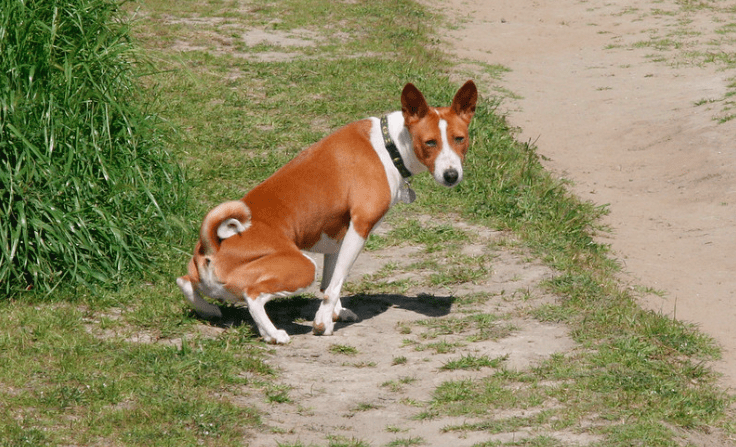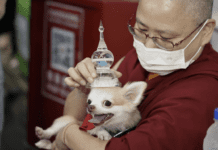Last Updated on April 10, 2021 by Dogs Vets
As rough as it may seem, we all checked our dog’s feces. And, in fact, it’s a good habit to check your dog’s poop. Dog poop (or “stool”) can tell us a lot about a dog’s health.
Changes in the color, consistency and frequency of dog feces can be one of the first signs of disease.
One of the most worrisome changes you may notice is blood in dog poop. If your dog is pooping, it’s a good idea to find out what’s causing it and what to do first.
Why is my dog pooping and vomiting?
Vomiting and blood passage in dogs can be a sign of hemorrhagic gastroenteritis or HGE – a potentially life-threatening condition that occurs when a large amount of fluid leaks into the intestines and your dog becomes dehydrated very quickly.
While they may indicate other problems, if your dog exhibits these symptoms as if your dog does have HGE, contact your veterinarian immediately and they will need emergency treatment.
Is blood in dog poop an emergency?
It depends. The possible causes vary so much that the bleeding poop may be a minor problem or it may be a sign that urgent treatment is needed. This is why you should talk to your veterinarian as soon as possible, and after discussing your dog’s symptoms and performing an examination, they will be able to advise you on the next steps.
View this post on Instagram
If you think your dog’s condition may be life-threatening or require urgent treatment, contact your veterinarian to visit the nearest Vets Now emergency pet clinic during non-working hours so that he or she can be treated as soon as possible.
Why is your dog pooping blood?
Seeing blood in dog poop can be alarming, and it can be caused by many different reasons.
Eating bad food or getting new food for your dog
dog pooping blood can also be the result of something affecting your dog’s digestive tract (this can happen anywhere in the stomach, small intestine, colon or anal area).
Common diseases that affect the digestive tract (gastrointestinal tract) include inflammation, and the presence of blood in this tract is called “gastroenteritis” or “hemorrhagic gastroenteritis”.
Any of these can occur when your dog eats something he or she should not. This may include non-food items such as
- Bones
- Sticks
- Toys
- Toxins
- Garbage
This can also happen when there is a change in diet, such as the introduction of a new food, snack or chew toy, or when your dog eats another pet’s food.
Infections, parasites or cancer affecting the gastrointestinal tract
Other conditions that may affect the digestive tract and cause bleeding stools include:
- Infections (viruses such as bacteria or microviruses)
- Parasites (intestinal worms, coccidia, Giardia)
- Cancer, in some cases
- Diseases or problems that affect blood clotting
- Blood in the stool may also be seen in cases “outside” the digestive tract.
This may include problems that interfere with normal blood clotting, such as:
- Bleeding disorders
- toxins
- Liver disease
- Kidney disease
- Immune system disorders
- Hormonal imbalance
- Cancer
What does blood in dog poop look like?
Bloody stools can appear in several different ways. The color and appearance of the blood helps determine which part of the digestive system the blood is coming from.
Blood in the stool: bright red blood in dog poop
“Blood in the stool” is a term used to describe when there is bright red blood in a dog’s feces. In this case, the blood is bright red because it comes from the lower part of the digestive tract (colon, anus and rectum).
It is also bright red because it has not undergone the entire digestive process and usually looks “fresh” when it leaves the body.

When blood is seen in the stool, it is usually accompanied by diarrhea and will have a light red appearance. The dog may go to the bathroom more frequently and the stool volume may be greater. The consistency can range from a soft, formed texture to completely liquid.
Sometimes the formed stool will also be covered with mucus and the blood will look like the outside of the feces. This also indicates a problem in the lower part of the digestive tract (e.g., the colon).
Melina in Dogs: Black and Tarry Boat Tail
If the blood is coming from the upper part of the digestive tract (stomach or small intestine), it will appear dark, almost black and tarry.
Some owners are unaware that dark colored stool may actually mean the presence of blood. This is called “melena”.
Black spot disease in dogs can occur in any condition that affects the upper part of the stomach or intestines, including inflammation, ulcers and cancer.
With black cats, the dog’s stool usually looks stronger.
Pure blood in dog stool
It is also important to note that in some cases, you may see a dog bleeding only without stool.
If the feces are liquid, or if the intestines are empty, all the blood may be coming out.
View this post on Instagram
What to do if your dog has a bowel movement
If you think your dog is pooping blood, the best thing to do is to call your veterinarian. In some cases, talking over the phone can help determine if your dog needs to see his veterinarian.
Home Care
In some cases, home care may be appropriate.
For example, eating colored foods such as beets or red-dyed snacks may cause false blood to appear in your dog’s stool.
Consider all the things your dog may have touched or given in the first few days. This will help you and your veterinarian determine the best next steps.
When to visit the vet
Take your dog to the veterinarian if they begin to have stools and show any of the following symptoms.
- Appears weak or lethargic
- When Gums are pale (white or pale pink, not the normal salmon pink)
- Vomiting
- Refusing food or water
- When dog Become unresponsive
These may be a signs of more serious shock and illness.
What is the treatment for dog pooping blood ?
Since there are a variety of reasons why a dog may have a bowel movement, treatment will depend on the presumed cause.
After examining your dog, your veterinarian will provide a list of possible causes. They may need to perform blood, urine and fecal tests, as well as X-rays or ultrasounds to identify the cause.
Treating digestive discomfort
If a simple digestive upset is caused by a change in diet or inflammation, your veterinarian may prescribe an easy-to-digest (bland) diet and medications to feed your dog.
Medications may include probiotics, antibiotics, antacids or other medications.
Treating Dehydration
If your dog appears to be dehydrated, your veterinarian may also recommend giving your dog water.
In mild cases of dehydration, your veterinarian may allow fluid loss under the skin and send your dog home for further care.
In more severe cases, intravenous fluid therapy may be required and hospitalization may be necessary for monitoring and more intensive support.
Can my dog possibly die from dog pooping blood?
Yes, if there is a large loss of blood through the digestive tract or a large loss of fluid due to vomiting or diarrhea, it can be life-threatening.
Severe dehydration and blood loss (resulting in anemia) can have serious consequences for your pet.
This can include shock, difficulty breathing, damage to internal organs and untreated death. If you are unsure of your dog’s condition, it is always best to contact your veterinarian.
Which home remedies are good for dogs with bleeding diarrhea?
Never turn to home remedies for your dog’s bloody stool without first consulting your veterinarian. Even if your dog has bloody diarrhea but is behaving normally, there is still a chance that emergency treatment may be needed. While there is ultimately nothing to worry about, it is best to err on the side of caution and not take any chances.
See also: Top 7 Mountain Dog Breeds with their common Lifestyle
Fact Check
We strive to provide the latest valuable information for pet lovers with accuracy and fairness. If you would like to add to this post or advertise with us, don’t hesitate reach us. If you see something that doesn’t look right, contact us!
Reference: petmd.com






